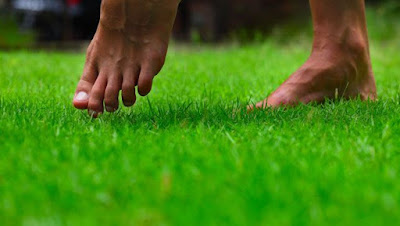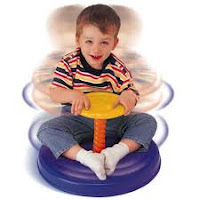Sensory Processing Disorder (SPD)
Part Two: How is a Sensory Processing Disorder Diagnosed?
A Checklist for Parents
by Trisha Roberts
It is important to seek professional help if a Sensory
Processing Disorder is suspected.
Occupational Therapists, Speech Therapists and some Physical Therapists
are trained in the area of Sensory Integration and will be able to evaluate
your child and design a treatment plan. The following information is a guideline
for helping parents decide whether they should seek additional help.
Professionals can diagnose and determine in which category your child is
struggling, how it is impacting their life and levels of performance.
I. Sensory Modulation Disorder refers to individuals who seek sensory stimulation due to an under or over response to sensory stimuli.
Signs of Over-Responsivity:
- Distressed by textures of fabrics, foods, hair products, etc. to the point of interfering with normal function
- Upset by the smell of perfume or cologne
- Dislikes hair combing or brushing
- Disturbed by clothes rubbing on skin; may want to wear shorts and short sleeves year-round, or only loose clothing
- Pulls off diapers and clothes, prefers to be naked
- Dislikes brushing teeth
- Is aversive to face being washed
- Overly distraught during diaper change
- Eats only soft or pureed foods past 2 years of age
- Gags with textured foods
- Avoids eye contact
- Experiences difficulty with sucking, chewing, and swallowing; may choke or have a fear of choking
- Resists wearing new clothes or clothes with rough textures
- Irritated by seams in socks and may refuse to wear them
- Avoids crowds and noisy places (movie theater, athletic stadium,
shopping mall, parades, concerts, etc.)
- Experiences motion sickness that is unrelated to other medical causes
- Irritated by household or cooking smells

Irritated by Food Smells - Sensitive to movement; avoids swings, merry-go-rounds and slides. Gets dizzy or nauseated easily
- Fearful or anxious of standing in close proximity to other people; may resist standing in lines
- Dislikes kissing, cuddling or hugging; may “wipe off” kisses
- Runs away, cries, or covers ears with loud or unexpected sounds
- As an infant, did not like to be held or cuddled--arching away from parent and/or crying
- Overreacts to minor cuts, scrapes, or bug bites
- Walks on toes the majority of the time
- May get fearful, anxious or aggressive with light or unexpected touch
- Feels seriously discomforted, sick or threatened by normal sounds, lights, movements, smells, or tastes
- Distracted by sounds not normally noticed by others, often to the point of being unable to concentrate on any other activity; hum of refrigerators, heaters, fans, or clocks ticking
- Prefers the dark; may cover or shade eyes with hand when in the light
- Asks people to be quiet; stop making noise, humming, talking, or singing
- May be a picky eater; avoids certain foods and may have a very limited diet
 |
| Aversion to Certain Foods and Textures |
- Does not like foods to be mixed
- Sensitive to bright lights; will squint, cover eyes, cry and/or get headaches from the light
- May avoid hot or cold foods
- May refuse to play at someone's house because of the way it smells; decides whether they like someone or some place by the way it smells
- Resists trying new foods
- Avoids “messy” play (dislikes paint, sand, glitter, play dough, glue, etc.)
- Resists fingernail or toenail cutting
- Bothered by background environmental sounds like outside construction, traffic noises, lawn mowing
- Hates getting hair cut

Aversion to Haircuts - Dislikes toothpaste and mouthwash
 |
| Brushing Teeth is a Battle |
- Wipes or washes hands frequently or gets distraught when hands get dirty
- Excessively ticklish
- Reacts negatively to smells which do not usually bother, or get noticed, by others
- Avoids elevators and escalators
- Fearful of the sound of a toilet flushing, dog barking, vacuum, hairdryer, squeaky shoes, door bell
- Appears restless and fidgety
- Has difficulty getting to sleep or waking up because of a slight sound
- May dislike certain people because of the sound of their voice
 |
| Dislikes Going Barefoot in the Grass |
- May refuse to walk barefoot on grass, shag carpet, or sand
- Refuses to eat certain foods because of the way they smell
- Finds it difficult to self-calm
Signs of Under-Responsivity:
 |
| Excessive Drooling |
- Shows extreme difficulties waking up
- Unaware of being touched or bumped unless done with extreme force or intensity
- Seems to ignore certain sounds
- Unaware that face or hands are dirty; may not feel that nose is running
- May not be able to identify which part of their body was touched if they were not looking
- Appears unreactive and slow
- Excessive drooling past the teething stage
- May have experienced little or no babbling as an infant
- Appears to make noise just to make noise
- Unaware of pain; not bothered by injuries, like cuts and
bruises
- Shows little or no distress with
vaccinations
- Fails to notice or ignores unpleasant
odors
- Might appear deaf even when hearing is normal; may not respond when
name is called
- Difficulty with toilet training, unaware of being wet or soiled
- May need directions repeated often, or will say, "What?" frequently
Signs of Sensory Craving:
- Fidgets excessively
- Seeks or makes loud, disturbing noises
- May crave touch, needing to touch everything and everyone
- Seeks out and enjoys messy play
- Looks for surfaces and textures that provide strong tactile feedback; may constantly rub against the object
- Loves being tossed in the air
- Could spin for hours and never appears to get dizzy

Could Spin for Hours - Loves jumping on furniture, trampolines, jumping off objects, spinning in a swivel chair, or getting into upside down positions
- Enjoys swinging as high as possible and for long periods of time
- Prefers food with strong flavors--excessively spicy, sweet, sour, or salty
- Climbs, jumps and crashes constantly
- Searches for "extreme" sensations
- Kicks feet on chair or floor while sitting at desk
- Loves to drag, push or pull heavy objects
- Seeks out fast or spinning activities
- Loves fast, intense rides at amusement parks
 |
| Craves Fast, Intense Activities |
- Wants to be tightly wrapped in many blankets at bedtime
- Prefers clothes to be as tight as possible
- Sucks on or bites clothing, fingers, pencils, etc.
- Chews on straws, pencils, shirt sleeves, hair

Chewing on Hair or Other Non-Food Objects - Mouths objects excessively beyond infancy
- Frequently crack knuckles
- Enjoys excessively loud music; turns TV, radio or headphones to high volume
- May be self-abusive; pinching, biting, or banging head
- Enjoys “roughhousing” and wrestling types of play
- Bangs toys and objects excessively
- Craves deep pressure and hugs
- Grinds teeth during the day
- Appear impulsive
- Demonstrates high level of risk-taking behavior; seems unaware of danger; may be reckless
II. Sensory-Based Motor Disorder refers to individuals who incorrectly process motor information, leading to poor motor skill performance.
Signs of Sensory Motor Based Problems:
- Appears slow, clumsy and uncoordinated
- Demonstrates poor motor skills
- Poor handwriting

Poor Handwriting - Slumped posture; difficulty sitting or standing erect
- Delayed development of crawling, standing, walking or running
- Difficulty attending to, understanding, and remembering what is said or read; often asks for directions to be repeated and may only be able to understand or follow two sequential directions at a time
- Slow to develop hand preference, not clearly right or left-handed by age 5
 |
| Slumped Posture |
- Unable to throw or catch a ball
- Displays an awkward grip on pencils or other writing tools
- Grips items too tightly or too loosely; frequently spills liquid out of drinking glass
- Displays poor coordination in fine motor tasks, such as cutting, holding a marker or pencil, manipulating fasteners (zippers, snaps, buttons), opening and closing containers, stringing beads, putting on clothing (shoes, socks, jacket, pants), etc.
- Unable to eat well using fork, spoon, and knife
- Frequently drops or spills thing
- Written work is messy, often rips the paper when erasing
- Unable to drink from an open cup or straw
- Appears overly messy when eating compared to other children their
age
- Exhibit difficulties in imitating age-appropriate shapes and letters
- Has trouble coloring within the lines
- Excessively short attention span for age
III. Sensory Discrimination Disorder refers to individuals who typically have poor postural control, have difficulty attending to tasks and lack body organization.
Signs of Sensory Discrimination Problems:
- Drops things constantly
- Frequently breaks toys and objects, exerting too much force
- Poor handwriting
- Difficulty dressing and eating
- Struggles to use scissors
- Uses inappropriate force to handle objects
- Participates in repetitive play for hours; lining up blocks or toy cars, watching one movie over and over
- Frequently bumps into things, trips, knocks things over, or appears clumsy
- Poor balance and righting reflexes
- Seems weaker than other children
- Frequently trips or falls for no apparent reason
- May be a messy dresser; looks untidy, does not notice shirt is not tucked, shoes are untied, pants are twisted, collar of shirt is up, etc.
- Appears stiff and rigid, or loose and floppy
- May have difficulty articulating and speaking clearly
- Low muscle tone
- Frequently “W-sits” on the floor to stabilize body
 |
| W-Sitting to Stabilize Body |
- Poor core (trunk) control
- Avoids playground equipment like swings, ladders, slides, or merry-go-rounds
- May appear terrified of falling even when there is no real risk of it
- Prefers playing alone with objects or toys rather than with people
- Terrified of heights, even the height of a curb or small step
- Excessive difficulty accepting changes in routine
- Fearful of feet leaving the ground
- Nervous walking up or down stairs or walking on uneven surfaces
- Afraid of being tipped upside down, sideways or backwards
- Difficulty learning an exercise or dance steps
- Stomps feet when walking
- Difficulty
climbing stairs

Clumsy with Poor Body Control and Frequent Stumbling - Unsure about how to move body during movement, for example, negotiating an obstacle course, retrieving a ball from under a table, stepping over an object in their path
- Unable to assume a "superman" or “V-up” position (lifting arms and legs together when lying on tummy)
- Often interrupts, talks out of turn, or "off topic"
- Unable to stand on one foot with eyes open
- Difficulty jumping, hopping, galloping, skipping or performing a “Jumping
Jack”
- Unable to kick a moving or stationary ball
- Struggles to turn doorknobs, handles, or to open and close items
- Unable to catch or throw a ball overhand
- Difficulty getting along with peers
 |
| Frequently Breaks Pencils and Crayons by Using Too Much Force |
- Unable to regulate pressure when coloring or writing; frequently breaks crayons or ends of pencils; coloring or handwriting may be too faint to see
- Difficulty getting on or off playground equipment; need assistance to use properly
- Fearful of riding a bike or difficulty riding a tricycle or bike
- Unable to locate the source of a sound
- Moves slowly and cautiously, avoids taking risks, prefers sedentary activities
- Low endurance; tires quickly with minimal work
- Difficulty sitting upright in a chair; frequently slumped over desk or table
- May not be able to identify objects by feel; needs to use vision to help find an item in desk or backpack
Do not panic if your child has several of the indicators above! No one is perfectly regulated all of the time; we all have some sensory integration problems now and again due to an overload or deprivation of sensory stimulation. But if a large number of the indicators above describe your child on a regular basis and are interfering with daily life, I encourage you to seek help. Start with your Primary Care Physician (PCP), your local Early Intervention Program (available in each state for children birth to 3 years old), or your child’s teacher. They should be able to put you in touch with someone who can start the evaluation process.
We will continue this topic with our next blog:
Part Three: Strategies for Treating a Sensory Processing
Disorder
We carry many great Sensory and Tactile Toys for children. Visit our Retail Website Here.
We carry many great Sensory and Tactile Toys for children. Visit our Retail Website Here.
Author: Trisha Roberts
proeducationaltoys@gmail.com
Copyright © 2016 TNT Inspired Enterprise, LLC, All rights reserved.
Unauthorized duplication is a violation of applicable laws.





No comments:
Post a Comment